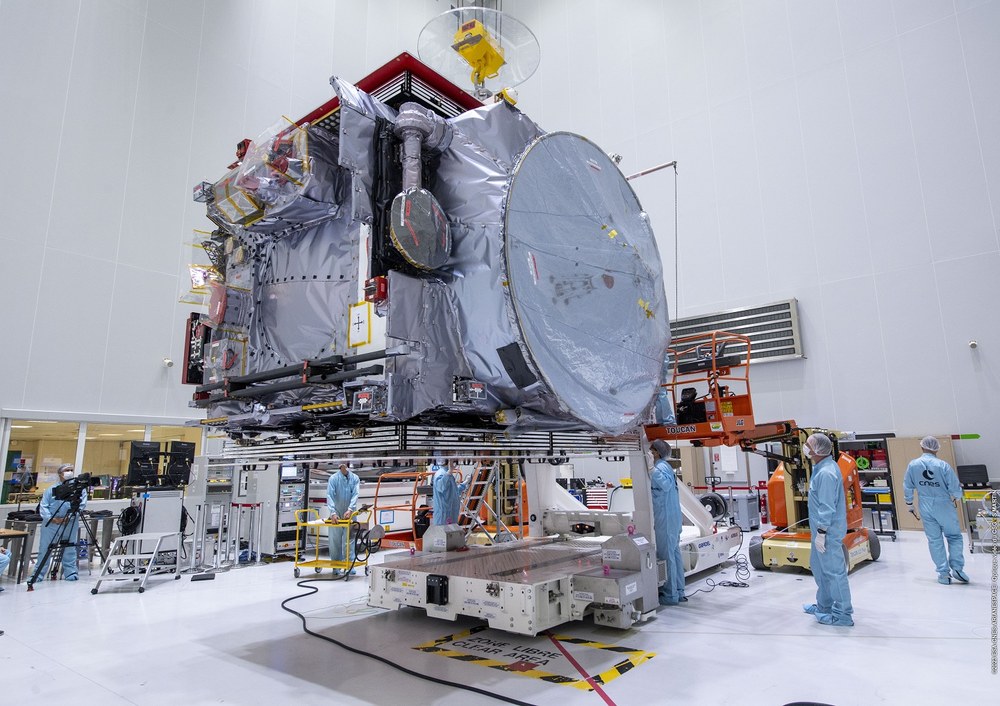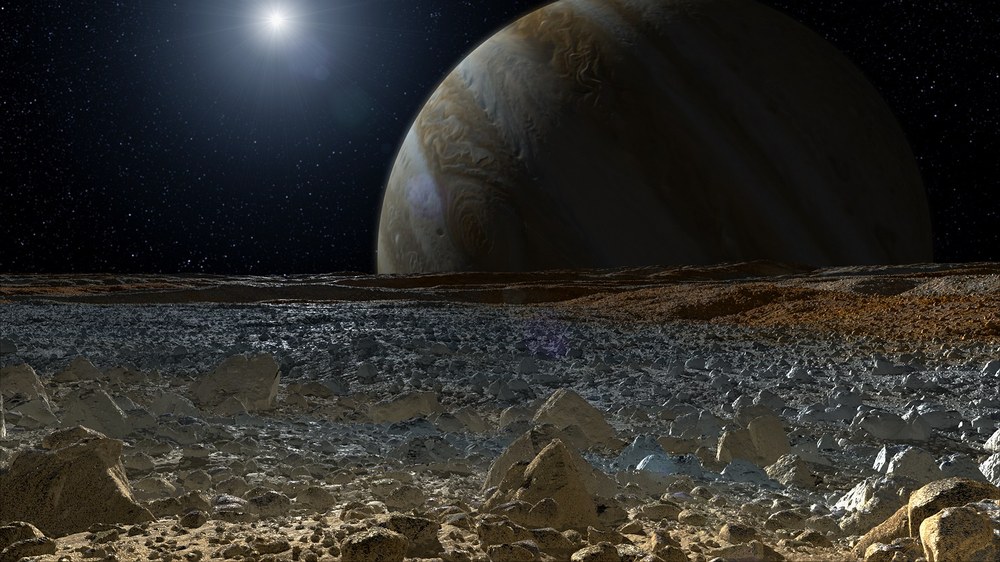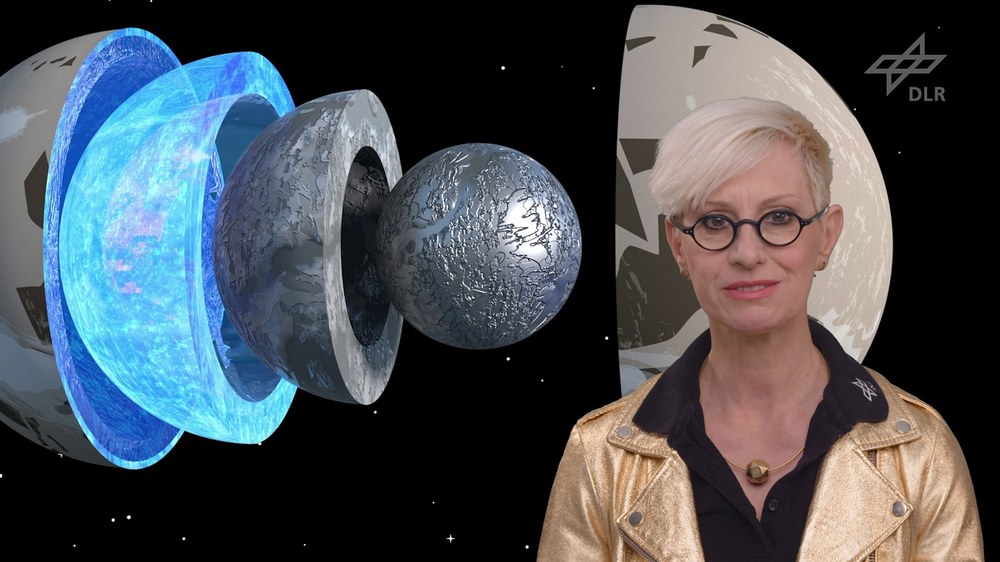JUICE – an unprecedented journey to Jupiter



- The JUpiter ICy Moons Explorer (JUICE) spacecraft is scheduled to begin its eight-year journey to Jupiter on 13 April 2023, lifting off from Europe's spaceport in Kourou atop an Ariane 5 launch vehicle.
- After arriving in the Jupiter system in July 2031, JUICE will study the planet and in particular its icy moons from orbit around Jupiter and later around the moon Ganymede.
- Germany is contributing 21 percent to the ESA science programme and thus to financing the costs of developing and constructing the platform, launching and operating JUICE.
- In addition, the German Space Agency at DLR is funding seven of the 10 scientific instruments on JUICE with approximately 100 million euros.
- The DLR Institute of Planetary Research is providing the GALA laser altimeter and making significant contributions to the JANUS camera.
- Focus: Spaceflight, Jupiter, Solar System exploration, search for life
+++ UPDATE: On 14 April 2023 at 14:14 CEST, the Ariane 5 rocket with the JUICE space probe on board was successfully launched from the European spaceport in Kourou. At 15:04 CEST, the spacecraft's signal was aquired by ESA's European Space Operations Centre (ESOC) in Darmstadt, and at 15:33 the solar panels were deployed. JUICE is now on its way to Jupiter. +++
Is there life beyond Earth – perhaps even in the Solar System? This fundamental question continues to motivate the scientific community worldwide. On 13 April 2023, a spacecraft will set off from Europe's spaceport in Kourou, French Guiana, on a long research journey to address this and many other questions. A journey like no other – the European Space Agency's JUpiter ICy Moons Explorer (JUICE) mission will spend eight years making its way to the largest planet in the Solar System, where it will take a close look at its mysterious icy moons.
In the process JUICE will achieve many firsts. JUICE will be the first spacecraft to use an extremely close – only 750 kilometres away – flyby of the Moon, and 36 hours later of Earth to gain momentum, the first to change orbit from around another planet to one of its moons and the first to orbit a moon other than Earth's. The GAnymede Laser Altimeter (GALA) is the first instrument of its kind to be used in the outer Solar System to scan the surface in three dimensions and thus determine the topography and shape of these moons.
Germany is also part of this exciting journey. The German Space Agency at the German Aerospace Center (Deutsches Zentrum für Luft- und Raumfahrt; DLR), based in Bonn, is supporting JUICE by making the largest single contribution of any ESA member state – 21 percent – to the mission. These funds are part of the financing of the spacecraft, the launch with an Ariane 5 launcher and the mission operations. In addition, approximately 100 million euros will go towards German contributions to seven of a total of 10 scientific instruments on the spacecraft. The DLR Institute of Planetary Research in Berlin is involved in two of these instruments – the GALA laser altimeter was created under DLR's leadership and DLR was part of the Italian-led consortium for the JANUS camera.

Video: Journey to Jupiter - JUICE and Germany's contribution
Your consent to the storage of data ('cookies') is required for the playback of this video on Youtube.com. You can view and change your current data storage settings at any time under privacy.
"The JUICE mission is the result of successful collaborations at national and European level. After a flight through the Solar System, the DLR instrument GALA on board the JUICE spacecraft will create an elevation model of Jupiter's icy moon Ganymede. The laser altimeter will be used to measure the deformation of Ganymede's ice crust over a period of months. From the amount of deformation, we will be able to determine whether there is an ocean of liquid water beneath the ice crust and how thick the crust is," explains Anke Kaysser-Pyzalla, Chair of the DLR Executive Board. "And what would such a mission be without a camera, so that we on Earth can take part in it? Key components of the JUICE camera hardware were developed and built at the DLR Institute of Planetary Research in Berlin. The JANUS camera system from our Italian partners will provide us on Earth with high-resolution images of the surfaces of the icy moons Ganymede, Callisto and Europa from a few hundred kilometres away."
"ESA's largest interplanetary mission to date is setting off for the biggest planet in the Solar System. JUICE will observe and measure Jupiter and its three large icy moons – Ganymede, Callisto and Europa – in flyby and from orbit using cameras, spectrometers, radar and lasers. Two important instruments were developed and built under German leadership. German institutions are playing a decisive role in another five," says Walther Pelzer, DLR Executive Board member and Director General of the German Space Agency at DLR.
In addition to GALA, a second instrument on board was developed and built in Germany – the Submillimetre Wave Instrument (SWI) of the Max Planck Institute for Solar System Research in Göttingen. This will study the middle atmosphere of Jupiter as well as the extremely thin atmospheres and the surfaces of the 'Galilean moons' Ganymede, Europa and Callisto. For the Italian instrument JANUS (Jovis, Amorum ac Natorum Undique Scrutator), which will primarily observe geological structures of the icy moons partly in high resolution, key parts of the camera system were developed and built by the DLR Institute of Planetary Research.
In addition, the German Space Agency at DLR is funding contributions to the Particle Environment Package (PEP) particle spectrometer, the Jupiter Magnetometer (J-MAG), the Radar for Icy Moons Exploration (RIME) instrument and the instrument for radiosounding the Jupiter atmosphere (3GM) from the National Space Programme.
A traveller like no other
For a special journey, you also need a special 'vehicle'. The JUICE mission's spacecraft has to fulfil complex tasks on its way to the first planet of the outer Solar System. The distance alone presents three challenges. First, the collected data takes 30 to 50 minutes to get back to Earth and new commands take just as long to arrive at the probe. Secondly, the gas giant is 778 million kilometres away from the Sun. Accordingly, it is cold and dark out there. But since the probe also passes Venus, which is close to the Sun, on its way, it must withstand temperature fluctuations of +250 and -230 degrees Celsius on its journey. An elaborate thermal control system consisting of active and passive components, including a new type of Multi-Layer Insulation (MLI), will keep the internal temperature stable. And thirdly, the Sun's light is extremely weak at Jupiter – 25 times weaker than on Earth. Two solar arrays, each with five panels, cover a huge area of 85 square metres and deliver approximately 700 to 900 watts of electrical power. The batteries on board allow the spacecraft to endure eclipses lasting up to five hours. Once JUICE has arrived at Jupiter, the strongest radiation field in the Solar System is 'lurking' in front of and, above all, behind the gas giant.
The instruments also have to be designed to remain functional despite the harsh radiation environment. Close to Jupiter, particles such as protons, electrons and ions from the solar wind and from the volcanic ejections from the moon Io are captured by the planets magnetic field: "The magnetic field accelerates these particles, turning them into small, charged projectiles that will constantly bombard our GALA laser altimeter. To protect the particularly sensitive components of the instrument from this extremely strong radiation, a very special design has been developed. This is the first time such an instrument has been used in the outer Solar System," explains Heike Rauer, Head of the DLR Institute of Planetary Research and she adds: "JUICE is really breaking new scientific ground and will generate data sets with its measurements that will make completely new scientific statements possible and that will complement the results of other missions such as NASA's Europa Clipper perfectly."
An itinerary unlike any other
"To reach the Jupiter system safely and on schedule, the spacecraft is taking a very special travel route. Like on any long trip, JUICE will head for various waypoints to 'fill up' with kinetic energy. After its launch into an orbit around the Sun, the spacecraft will first perform a flyby of Earth and the Moon in August 2024 and gain momentum. This momentum will catapult JUICE to Earth's neighbouring planet, Venus, where it will again significantly increase its speed with the next flyby in August 2025. After that, it will return to Earth twice more, in September 2026 and January 2029. JUICE will then have gained so much momentum through two more close fly-bys of our home planet that the spacecraft will finally reach Jupiter in July 2031. Jupiter orbits just over 600 million kilometres away from the Sun," says Christian Chlebek, JUICE Project Manager at the German Space Agency at DLR, explaining the complex flight manoeuvres of the JUICE mission. Once it arrives at Jupiter, the spacecraft will enter an orbit around the gas giant and make a total of 35 close flybys of the icy moons from July 2031 to November 2034.
After that, things will get exciting again in December 2034. For the first time ever, a spacecraft will change from orbiting another planet to orbiting one of its moons. When JUICE reaches the moon Ganymede, it will also be the first spacecraft ever to orbit a moon other than Earth's natural satellite. In the final part of this journey, DLR's GALA instrument will primarily scan this moon's ice shell for evidence of a subsurface ocean, before JUICE impacts the moon's surface at the end of the mission.
Jupiter and its icy moons
Jupiter was created when the other planets and moons of the Solar System formed after the Sun about 4.5 billion years ago. Gravity pulled swirling gas and dust together to form this giant gas planet, whose diameter of 138,000 kilometres is more than 10 times that of Earth. Jupiter absorbed most of the mass left over after the Sun's formation and ended up with more than twice as much material as all the other bodies in the Solar System combined. In fact, Jupiter has the same components as a star, but it did not become massive enough to become one.
The moons Ganymede, Callisto and Europa, also referred to as the 'Galilean moons' because of their discoverer, are suspected to harbour oceans of water beneath their icy surfaces. This is the element that makes Earth so unique, and it is considered a fundamental prerequisite for life.
Jupiter and its icy moons are not only a significant part of the Solar System but can also help scientists to learn more about the environment around other stars. Thousands of extrasolar planets (exoplanets) have already been discovered. Many of these distant worlds are gas giants like Jupiter. They are too far away to send spacecraft to explore them, but by studying Jupiter, conclusions can be drawn about what these worlds might look like.
